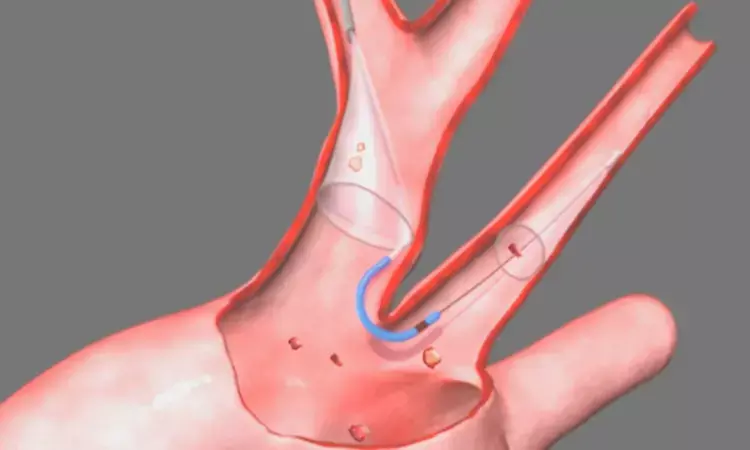- Home
- Medical news & Guidelines
- Anesthesiology
- Cardiology and CTVS
- Critical Care
- Dentistry
- Dermatology
- Diabetes and Endocrinology
- ENT
- Gastroenterology
- Medicine
- Nephrology
- Neurology
- Obstretics-Gynaecology
- Oncology
- Ophthalmology
- Orthopaedics
- Pediatrics-Neonatology
- Psychiatry
- Pulmonology
- Radiology
- Surgery
- Urology
- Laboratory Medicine
- Diet
- Nursing
- Paramedical
- Physiotherapy
- Health news
- Fact Check
- Bone Health Fact Check
- Brain Health Fact Check
- Cancer Related Fact Check
- Child Care Fact Check
- Dental and oral health fact check
- Diabetes and metabolic health fact check
- Diet and Nutrition Fact Check
- Eye and ENT Care Fact Check
- Fitness fact check
- Gut health fact check
- Heart health fact check
- Kidney health fact check
- Medical education fact check
- Men's health fact check
- Respiratory fact check
- Skin and hair care fact check
- Vaccine and Immunization fact check
- Women's health fact check
- AYUSH
- State News
- Andaman and Nicobar Islands
- Andhra Pradesh
- Arunachal Pradesh
- Assam
- Bihar
- Chandigarh
- Chattisgarh
- Dadra and Nagar Haveli
- Daman and Diu
- Delhi
- Goa
- Gujarat
- Haryana
- Himachal Pradesh
- Jammu & Kashmir
- Jharkhand
- Karnataka
- Kerala
- Ladakh
- Lakshadweep
- Madhya Pradesh
- Maharashtra
- Manipur
- Meghalaya
- Mizoram
- Nagaland
- Odisha
- Puducherry
- Punjab
- Rajasthan
- Sikkim
- Tamil Nadu
- Telangana
- Tripura
- Uttar Pradesh
- Uttrakhand
- West Bengal
- Medical Education
- Industry
Does cerebral embolic protection prevent stroke in patients undergoing TAVR? PROTECTED TAVR provides answer

USA: The use of cerebral embolic protection (CEP) among patients with aortic stenosis undergoing transfemoral TAVR did not reduce the risk of periprocedural stroke, recent data from PROTECTED TAVR shows.
The researchers further add that the results may not preclude a benefit of CEP during TAVR. "There were lesser disabling strokes with protection, and the procedure itself was safe," Samir R. Kapadia, Department of Cardiovascular Medicine, Cleveland Clinic, Cleveland, OH, and colleagues wrote in their study. The findings were presented at the TCT 2022 and published in the New England Journal of Medicine.
Transcatheter aortic-valve replacement (TAVR) for treating aortic stenosis can result in the embolization of debris. The risk of stroke may be reduced by capturing debris that provides cerebral embolic protection.
The study included patients with aortic stenosis. They were randomly assigned 1:1 to receive transfemoral TAVR with CEP, which constituted the CEP group, and the control group without CEP. Stroke within 72 hours after TAVR or prior to discharge was the study's primary endpoint in the intention-to-treat population. The following parameters were assessed: death, disabling stroke, delirium, transient ischemic attack, acute kidney injury, and major or minor vascular complications at the CEP access site. All patients were examined at baseline and after TAVR by a neurology professional.
The study led to the following findings:
A total of 3000 patients across Europe, North America, and Australia underwent randomization; 1501 were allocated to the CEP group, and in the control group 1499 people were included.
Successfully deployed of the CEP device was done in 1406 of the 1489 patients (94.4%) in whom an attempt was made.
There was no significant difference in the stroke incidence within 72 hours after TAVR or before discharge between the CEP group and the control group (2.3% vs. 2.9%; difference).
Disabling stroke was seen in 0.5% of the patients in the CEP group and 1.3% in the control group.
There were no notable differences between the CEP group and the control group in the percentage of patients who died (0.5% vs. 0.3%); had a stroke, a transient ischemic attack, or delirium (3.1% vs. 3.7%); or had acute kidney injury (0.5% vs. 0.5%).
At the CEP access site, one patient (0.1%) had a vascular complication.
"Aortic stenosis patients undergoing transfemoral TAVR, CEP use did not significantly affect the incidence of periprocedural stroke; the results may not rule out a benefit of CEP during TAVR based on the 95% confidence interval around this outcome," the researchers conclude.
Reference:
Kapadia SR, Makkar R, Leon M, et al. Cerebral embolic protection during transcatheter aortic valve replacement. N Engl J Med. 2022; Epub ahead of print.
Dr Kamal Kant Kohli-MBBS, DTCD- a chest specialist with more than 30 years of practice and a flair for writing clinical articles, Dr Kamal Kant Kohli joined Medical Dialogues as a Chief Editor of Medical News. Besides writing articles, as an editor, he proofreads and verifies all the medical content published on Medical Dialogues including those coming from journals, studies,medical conferences,guidelines etc. Email: drkohli@medicaldialogues.in. Contact no. 011-43720751


